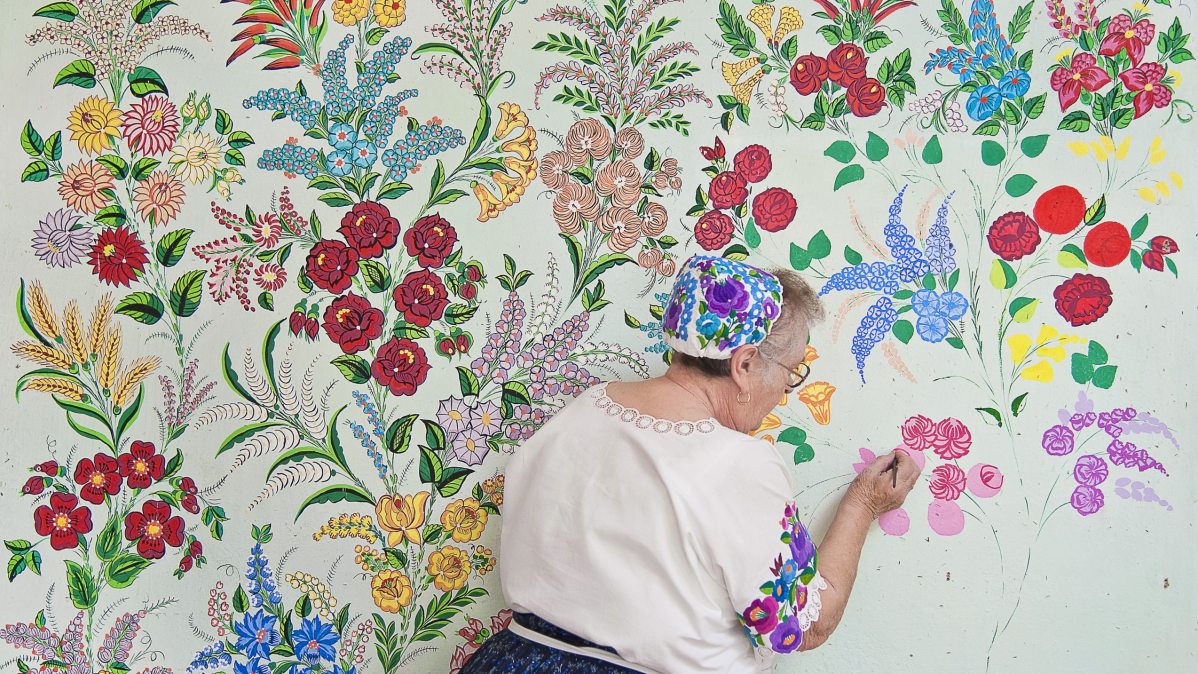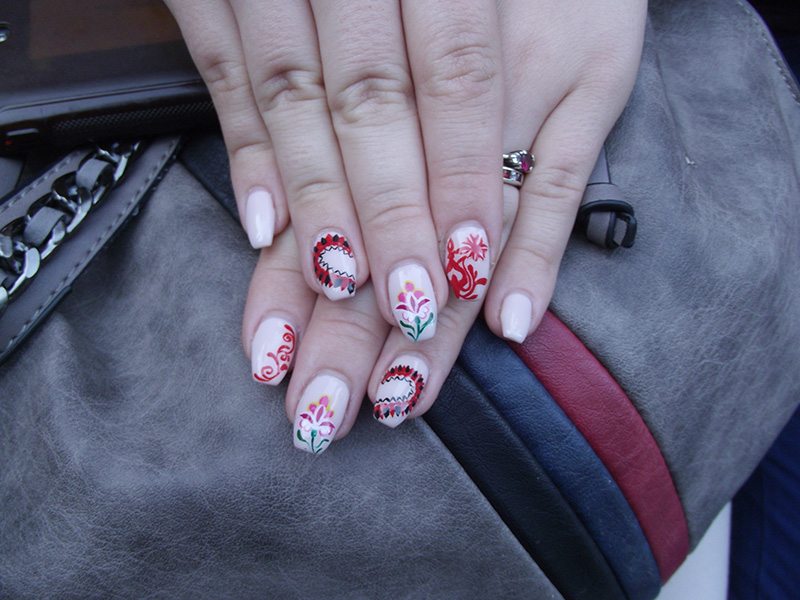
Our artistic soul from Kalocsa flowers to Buzsák dances
Explore Hungary's varied art traditions, reflecting unique local identities and customs from region to region.
Hungarian art traditions showcase the rich heritage and customs of local communities. These diverse expressions, from detailed embroidery to skilled craftsmanship, highlight the deep cultural connections rooted in Hungary's landscapes.
Kalocsa – Embroidery, ornamental painting, traditional dress and folk dance
The colourful flower motifs of the ornamental painting and embroidery of Kalocsa are known throughout the word and indeed have often been considered an emblematic symbol of Hungarian folk art. This branch of artistic expression has become a unique element of the traditional peasant culture of Kalocsa as well as the surrounding villages of Drágszél, Homokmégy, Öregcsertő, Szakmár, and Újtelek which were established in the 18-19th centuries.
The ethnic group referred to as Pota inhabiting the area known as Kalocsai Sárköz in south-central Hungary on the west bank of the Danube is distinct from surrounding groups in the characteristic dialect members used, their rich folk art and Catholic faith.The women of Kalocsa who still draw, paint and embroider in the traditional style are the bearers and the perpetuators of the local heritage. Traditional revival groups, folk dance groups, the local museum and folk art centre all contribute to the safeguarding of the characteristic culture and folk art that distinguishes Kalocsa identity.
The inhabitants of Kalocsa and the surrounding settlements are devoted to their folk heritage.They create numerous opportunities for the presentation of their traditional dances and attire: Midsummer Eve Festivities, Danube Folklore Festival, Kalocsa Paprika Festival, village feasts, and harvest celebrations. These events attract people of all ages and provide an excellent opportunity for the transmission of cultural heritage from generation to generation. The role of awareness raising and art education is also of paramount importance in the safeguarding and sustaining of the local heritage.
Mezőkövesd – Matyó embroidery, dress and folklore
Matyó or Matyóság is the collective term for the ethnographic group that emerged in the 18th-19th centuries in the historic market-town of Mezőkövesd at the juncture of the lowland Great Plain and the mountainous highlands in east-central Hungary.
Locally the inhabitants of neighbouring Tard and Szentistván villages as well as settlements at the foot of the Bükk mountains are also considered Matyós, however there are considerable differences culturally and the true Matyó cultural identity was always associated with Mezőkövesd. The residents of all three communities identify with the Matyó heritage and incorporate numerous elements of it in their daily lives and celebrations.
The unique folk art of the Matyó people developed as a result of the traditional folk culture, social structure and way of life - also reflected in the layout of the settlement. These were borne of an intellectual refinement rooted in a fervent Catholicism leading to centuries of economic, social and cultural development. At the time of the formulation of the Hungarian national cultural identity (turn of the 19th-20th century) Matyó folk art gained widespread popularity as the emblematic expression of ‘Hungarian-ness’.
The expressions of Matyó folk heritage: folk art, religious traditions, celebrations and rituals, traditional handicrafts and trades, folk dance, songs and music, poetry and language dialect are all as yet living elements of community life and culture. The Matyó culture is not a static heritage, but one that is in constant flux, ever recreated in content by the community that lives it. This vibrance reinforces the sense of identity of successive generations.
Sárköz – Weaving, embroidery, beading and costume
Sárköz is a culturally distinct region comprising five settlements (Decs, Öcsény, Sárpilis, Alsónyék and Báta) on the western bank of the Danube River in south-central Hungary. The rich folk art of the predominantly Calvinist Sárköz is a direct result of the rapid economic development transpiring in the 19th century after the regulation of the Danube and mitigation of flooding in the area.
The distinctive weaving, embroidery, collar-like beaded necklaces, elaborate costumes of colorful fine fabrics decorated with gabóca lace, the ornate female headdress of velvet, together with the distinctive spoken dialect, folk songs and dances of the region all contribute to the unique character of Sárköz cultural identity. Today the local ‘Wedding in Sárköz’ event embodies all of these cultural domains and serves as an exemplary program to present, safeguard and transmit the traditional folk art and folklore of Sárköz and to ensure its viability.
The local traditional handcraft artists – most belonging to the Folk Artist Association of Tolna County, the folk dancers, singers and musicians – primarily operating in revival associations – are the bearers and transmitters of the traditional Sárköz heritage. Local institutions of education also play a major role in raising awareness and ensuring survival of the cultural treasure by including the Sárköz heritage in the local curriculum.
Nagykunság – Wool embroidery
Nagykunság is situated in Tiszántúl (literally: over the river Tisza), in the south-eastern part of Jász-Nagykun-Szolnok County, where this particular element of folk embroidery culture can be observed.A variety of fur embroidery sewn with a fake flat-stitch wool yarn, patterns and their mode of composition and colours of linen embroidery are transmitted from generation to generation. Characteristics of the embroidery include the use of gradient yarns and rigorous construction with contour lines. Today, communities (embroidery circles, clubs, trade associations,) and individual embroiderers in eleven settlements maintain the tradition.
Buzsák – Embroidery, carving and folklore
There are four main segments of the traditions of Buzsák in Somogy County: embroidery, wood carving, folk dances and folk songs. There are three types of embroidery in the settlement: ‘vézás’ rich in stitch types and geometric patterns, ‘boszorkányos’ (witchy) with a black base, and appliqué (or Viennese according to the local name) made with overlay embroidery. Pastoral wood carving also contributes to the richness of folk art in Buzsák.
In addition to the tools of shepherding, other utensils were made and are still made of both wood and horn. Folk dances and folk songs are a significant living tradition in the life of the settlement. The most characteristic dance of Buzsák is the csárdás, some motifs of which are called ‘libegős’ (floating) and clog (or tap) dance.
Békés county – Furrier embroidery
The fur-making trade in Békés County appeared in an organized form in the first half of the 18th century, when the first guild was formed (1727). In the 19th century, in connection with the economic development of the county, the demand for high-quality housing culture and lavish clothing increased. The ornately embroidered ‘ködmön’ (sleeved sheepskin jacket) and ‘suba’ (cloak) were widespread pieces of wear for the population of Békés County.
The ‘ködmön’ made by the furriers was also an indispensable item in the dowry of the girls who were getting married. In terms of ornamentation and tailoring, four independent fur making centres were established in Békés County - in Mezőberény, Szarvas, Tótkomlós and Békéscsaba. The excellent masters developed their special compositions, ornamentation, colour schemes and cut lines characteristic of the furrier centre, which differed from others.In the 1970s, the artisans and activist groups of Békés County made great efforts to preserve the model world of the ‘ködmön’, which is why they continue to live on in today's folk crafts.
In accordance with the aims of UNESCO, the States Parties shall identify intangible cultural heritage elements within their territories and draw up inventories. In fulfilling this obligation in May, 2009 the Minister of Education and Culture has called on bearer communities, groups and individuals in Hungary to nominate recognized elements of their own Intangible Cultural Heritage (ICH) for inscription. Following the reccommendation of the ICH Committee, the Minister of Culture created two lists in service of the safeguarding Hungary's intangible cultural heritage, the National Inventory of ICH and the National Register of Best Safeguarding Practices.
For more Hungarian intangible cultural heritage, please visit this website.
